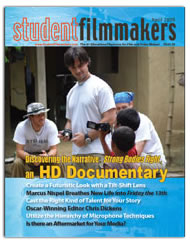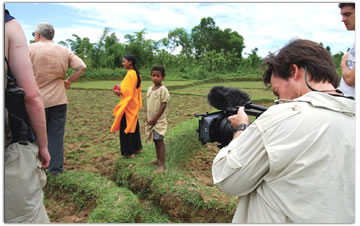HOW-TO, Techniques, & Best Practices Channel
| Capturing the Story for the HD Documentary Strong Bodies Fight By Staff posted Mar 2, 2010, 16:24 |
More production stills in the print edition. Get the Magazine delivered to your doorstep today! Order Bulk Subscriptions for your film school, library, or organization.
 Capturing the Story for the HD Documentary, "Strong Bodies Fight"
Capturing the Story for the HD Documentary, "Strong Bodies Fight"
Director’s Perspective
by William Donaruma
| Page 1 | 2 |
“Strong Bodies Fight” is an HD documentary that explores the history and the effect a university boxing team has on a culture far removed from their own. For eighty years, their boxing tournament known as the Bengal Bouts worked alongside the Holy Cross Missions to invest in the future of the children of Bangladesh. This film captures the strong spirit and beauty of the Bengali people and their country, as well as the courageous commitment of the Holy Cross priests, brothers, and sisters who have served there for 150 years. Director/Producer, William Donaruma, along with producer Mark Weber and cinematographer, John Klein, tells an inspiring story of sweat, sacrifice, and solidarity in the fight against global poverty. In the words of Fr. Leonard Shankar, “We are living in this world as a ‘we.’ It is not ‘I’ but ‘WE’ in this world.”

(Pictured) Overlooking India in the rice fields of a small village outside Srimangal. John gets hit with a ‘bug,’ and two crew members don’t make that portion of the trip either because of illness. So William films most of the day.
“Want to see how we treat a snake bite?” asks Father Homrich. My cinematographer, John, and I look at each other with unadulterated enthusiasm and run to grab our gear struggling to keep up with the elderly priest. We had heard rumors of how poisonous snake bites are treated in this small, poor village of Bangladesh, but didn’t think that we would be so fortunate as to witness one.
As we arrive at the small medical center, a young, petite woman is charging up a stun gun (the same type and model that American police officers use). We stare in awe as she proceeds to use the gun to zap the bitten man three times at a location on his lower leg around the puncture wound to neutralize the poison. Though it appears to be a routine, clinical procedure, it isn’t until she turns to us with a huge grin to exclaim how lucky this man is.
I glance at John to see if he is catching something I’m not but find the same thoughts mirror in his eyes: fear, confusion and an excitement about getting ‘the shot.’ The young nurse notices our confusion and explains that our patient is lucky because of the location of the bite. If the bite had been above the waist, they would not have been able to use the taser because of the intense voltage so near the heart. In this case, Father Homrich simply explains, “You die.”
John and I share another moment of kinship, nervously smiling at each other as we search the dirt floor around us for any hiding serpents. We watch with amazement as the patient’s friends help him out of his chair and usher him out the door. I turn to Father Homrich expecting to see a moment of concern. Instead, I see a smug and quite satisfied smile spread across his face, and as he looks back to the retreating patient he says, “They’re seeing how far he gets, or if he drops dead,” and laughs facetiously.
It wasn’t until the day we left the village that our colleagues divulged that Father had killed a cobra in our room the day we arrived in Pirgatcha. It was then I looked at John’s pale expression and remembered an old adage that my mother would always say: “Sometimes it’s better not to know than to know it all.”
From that moment forward, “cobra” became the code word for “you don’t want to know.”
In June 2008, I traveled to Bangladesh with 5 college student boxing team members and my cinematographer, John Klein (a former student). We set out to trace the affects of a 79 year old boxing tournament called “The Bengal Bouts,” which donates all of its proceeds to Holy
Cross missions in Bangladesh. One of my students and the captain of the boxing team, Mark Weber, came to me with the idea of going to Bangladesh in late 2007. Never before had the boxers met the people or viewed the region they were trying to help. His idea blossomed and the trip quickly became reality in early 2008. Mark and I acted as producers, while long time boxing coach and tournament referee, Tom Suddes acted as Executive Producer, raising money from boxing alumni to help fund the project. John Klein, who was working as a cinematographer in Chicago and had extensive experience with his own Panasonic HVX200 camera, came on board as well. I operated the B camera while directing the project.
We immediately knew we wanted to shoot in HD, and I had the resources to use two HVX200 cameras and several 16Gig P2 cards. I also brought a smaller HD camcorder that we could always have on hand and be able to put into obscure places.
We shot in 24PN on the Panasonics. This would allow us a solid 84 minutes on two 16G P2 cards. We also knew were going to shoot slow motion, which is achieved at this setting, anyway, and we could maintain a close to homogeneous timeline. The goal was to shoot as cinematically as possible, incorporating the land, colors, culture and conditions into the narrative and stay away from straight-forward interviews throughout. In doing so, we shot most everyone outside to showcase the landscape. Sound was just as important, so I also carried a recorder in order to pick up off camera sound bites, children singing, and natural sounds, etc. The directive was to avoid the pitfall of becoming a travel tour video and build transitions from each narrative segment that would help define the area where we were travelling.
There were many uncertainties travelling with equipment to this part of the world. One reason was that it was the rainy season, but another was the reputation of the airport, customs and possible corruption. I packed the gear so that we carried everything we would need to shoot something, even if nothing arrived at the airport. Much to our relief, getting in was easy, though we were without a tripod for the first full week of shooting. I pre-plan meticulously, and I had lists printed in each case with its inventory. We made sure we had power converters, inverters, and different kinds of batteries, but the one thing I hadn’t planned for was the frequency of the rolling black outs. After all of the research I had done about the area, I heard about power issues and was well prepared for camera power, but was not prepared for how often and for how long we would lose power for hard drives. An APC backup would have helped. We found this out the hard way when we first tried downloading our footage to 2TB LaCie Raid drives, and the power quit on us. This was in the city of Dhakka, and since it was so hot, it was more frequent because of electrical use. It is a country the size of Wisconsin with half the population of the United States, most of which are in the capital city. Luckily, we had plenty of P2 cards to rely on, but we quickly became backed up with footage that needed to be dumped. The P2 Store unit can only handle about 4 cards, so we were barely ahead of our resources, and we headed out to the rural northern missions just days into the trip. It is out in the these areas that we found out power didn’t just fluctuate, it was provided by generators that were cut off by the time we got settled back in with any time to off load the days work. When I say “settled,” I mean tucked into the netting around the bed and sweating it out.
Continued on Next Page...
| Page 1 | 2 |